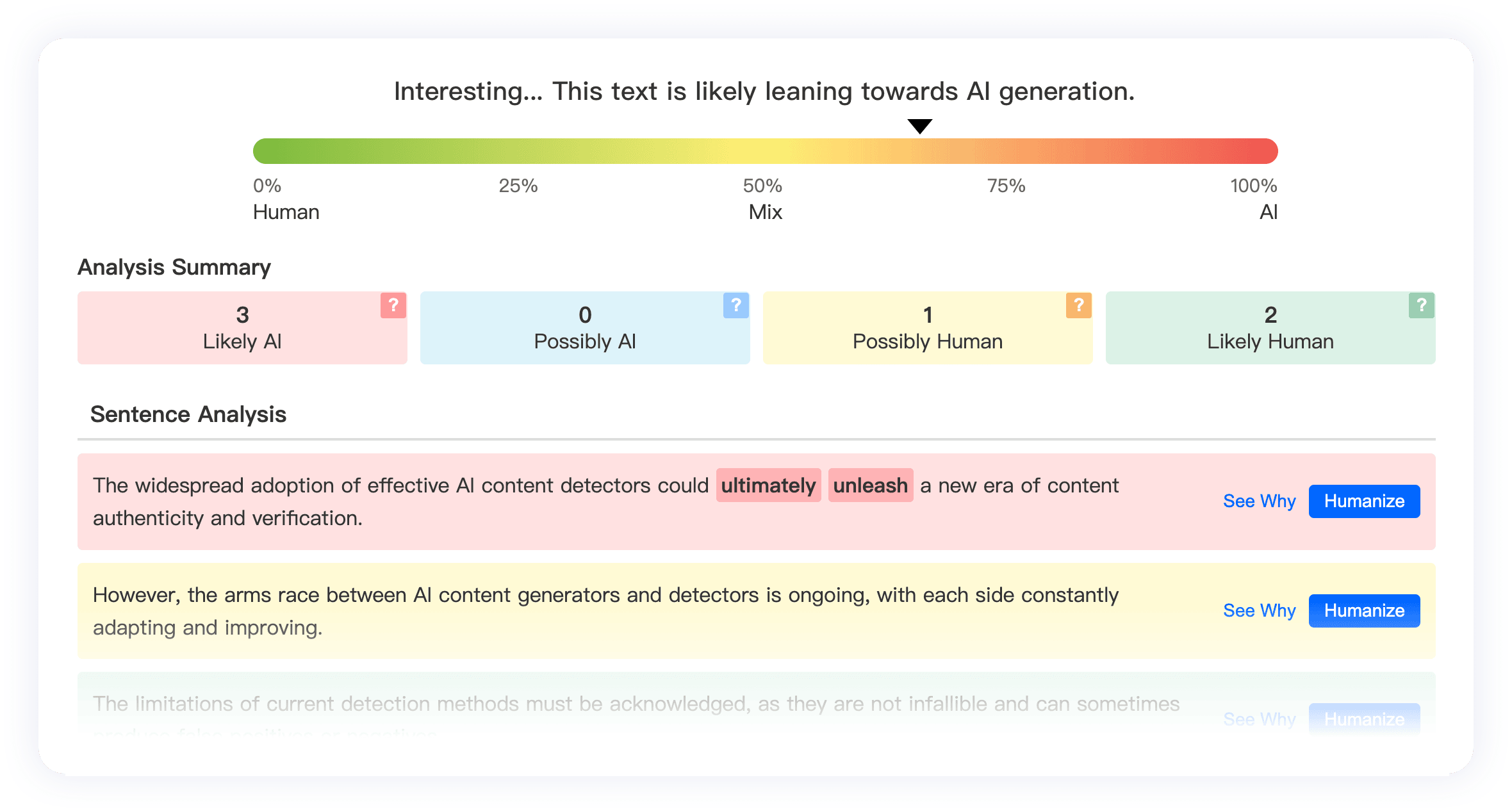uPass AI: AI Text Checker & Humanizer
✅ Free & No Signup Version ✅ Multilingual Support ✅ Unlimited Checks & Humanization ✅ Instant & Detailed Reports
Remaining Free Attempts Today:
Trusted by Students from 2,000+ Leading Universities




















Get In-Depth AI Detection Analysis
Get a comprehensive analysis including AI likelihood, a detailed summary, and sentence-by-sentence breakdown.
uPass AI Detector Reviews
uPass AI Key Features
-
AI Rewriting ToolsRefine AI-generated text with integrated rewriting tools. Make your content sound more natural and less detectable by AI systems.
-
Enhanced AccuracyuPass AI uses advanced algorithms to analyze text for patterns indicative of AI generation, providing reliable results.
-
User-Friendly InterfaceuPass AI is designed for simplicity. Easily paste your text and receive instant feedback, regardless of your technical expertise.
How uPass AI Works
-
1. Paste Your TextSimply copy and paste your text into the uPass AI input area. We support various text lengths, from short paragraphs to long articles.
-
2. Detect AI ContentOur powerful AI detection engine analyzes your text, comparing it against known patterns of AI-generated writing.
-
3. Improve and RefineUse the integrated AI rewriting tools to refine your text, making it sound more natural and less susceptible to AI detection.
uPass AI Analysis Report
-
1. Pass/Fail AI CheckuPass AI quickly tells you if your text is likely to pass an AI check or not. It gives you a result like: Likely Human, AI-Generated, or Mixed, along with a score to show how sure uPass is about the result.
-
2. Sentence Pass RateWant to improve your pass rate? uPass AI checks each sentence to see if it might stop you from passing. It groups sentences as: Likely Human, Possibly Human, Possibly AI, or Likely AI. See why each sentence is grouped and get help to make failing sentences more passable.
-
3. Tips to Guarantee a PassuPass AI gives you tips to help guarantee your writing will pass AI checks. This section offers simple advice on how to write less like AI and more like a real person, making your text more likely to pass and get through AI detectors.
Free Alternatives to uPass AI Detector
uPass AI FAQ
What is uPass AI?
uPass AI is a online detection tool designed to help you analyze your text and determine the likelihood of it being flagged as AI-generated.
The uPass AI helps users identify sections of their text that might be perceived as artificial or robotic. By highlighting these areas, it empowers users to refine their writing and create content that resonates with human readers.
Whether you are a student, writer, or content creator, uPass AI can be a valuable asset in ensuring the authenticity and originality of your work. It helps you maintain academic integrity, enhance your writing style, and create engaging content.
How accurate is uPass AI?
uPass AI strives for high accuracy by employing advanced algorithms and machine learning models. However, AI detection is an evolving field, and no tool can guarantee 100% accuracy. The effectiveness of the detector can vary depending on the complexity of the text, the specific AI model used to generate the content, and the sophistication of any attempts to bypass detection. We are constantly working to improve the accuracy of uPass AI to stay ahead of advancements in AI writing technology.
- Continuous Improvement: We regularly update our detection models to keep pace with the latest developments in AI writing.
- Contextual Analysis: uPass AI analyzes the context and flow of your text, not just individual words, to provide a more accurate assessment.
- User Feedback: We encourage user feedback to help us identify areas for improvement and further enhance the accuracy of the tool.
Who should use uPass AI?
uPass AI is a versatile tool suitable for a wide range of users:
- Students: Ensure your academic work is original and avoid unintentional plagiarism by checking your assignments with uPass AI.
- Writers: Enhance the naturalness and readability of your content, whether you are crafting blog posts, articles, or marketing materials.
- Content Creators: Maintain the authenticity of your online presence by verifying the originality of your website content and social media posts.
- Educators: Assess student submissions for AI-generated content and promote academic integrity in the classroom.
How does the AI Rewriter feature work?
The AI Rewriter feature within uPass AI is designed to help you refine AI-generated text or text that has been flagged as potentially AI-generated. It uses paraphrasing and rephrasing techniques to alter the sentence structure, word choice, and overall style of the text, making it sound more human-written. It’s important to note that the rewriter is a tool to assist you, and you should always review and edit the output to ensure it aligns with your intended meaning and style.
- Paraphrasing: The tool rephrases sentences and paragraphs to avoid repetitive patterns commonly found in AI-generated text.
- Synonym Replacement: It suggests alternative words and phrases to diversify the vocabulary and make the text sound more natural.
- Structure Variation: The tool modifies sentence structure and length to create a more varied and engaging writing style.
Can uPass AI detect all types of AI-generated text?
uPass AI is designed to detect a wide range of AI-generated text, including content produced by popular models like ChatGPT, GPT4, Gemini, Claude, LLAMA and others. However, AI technology is constantly evolving, and new AI models and writing styles are continuously emerging. While we strive to keep our detection capabilities up-to-date, it’s possible that highly sophisticated or novel AI-generated text might be challenging to detect with 100% certainty. We continuously update our algorithms to improve detection rates for new and evolving AI models.
How can I improve the naturalness of my AI-generated text?
uPass AI not only identifies potential AI-generated text but also offers tools and guidance to help you improve its naturalness. The AI Rewriter feature can help refine your text. Beyond using the tool, consider these tips:
- Add Personal Touches: Inject your own voice, perspective, and experiences into the text to make it more engaging and human-like.
- Vary Sentence Structure: Break up monotonous sentence patterns by using a mix of short, medium, and long sentences.
- Use Active Voice: Employ active voice whenever possible to make your writing more direct and dynamic.
- Read Aloud: Reading your text aloud can help you identify awkward phrasing or unnatural-sounding sentences.
- Human Editing: Always have a human editor review and refine your text to ensure it flows naturally and conveys your intended message effectively.
What if uPass AI flags my human-written text as AI-generated?
False positives can occasionally occur. If uPass AI flags your human-written text, don’t panic! Review the highlighted sections carefully. Sometimes, certain writing styles or phrasing might resemble patterns found in AI-generated text. Consider rephrasing those sections or adding more personal touches to make your writing clearly human. You can also contact our support team with any concerns.
- Review the Highlights: Carefully examine the sections flagged by the detector and look for similarities to AI-generated writing.
- Rephrase and Refine: Modify the flagged sections to make your writing style more distinct and human-like.
- Context Matters: Remember that context is crucial. Ensure that your writing clearly reflects your own thoughts and ideas.
How often is uPass AI updated?
We regularly update uPass AI to improve its accuracy, add new features, and keep pace with the latest advancements in AI technology. Our development team continuously monitors the AI landscape and refines our detection algorithms to ensure that uPass AI remains an effective tool for identifying and refining AI-generated content. We typically release updates on a monthly basis.
Disclaimer
Our uPass AI aims for high accuracy. However, achieving perfection is still challenging. Please note: the predictions are for demonstration purposes only. Do not rely on them for real-world applications. Use caution, as we are not liable for any damages incurred. We work hard to minimize false positives. This is especially important in situations requiring academic integrity, to avoid false accusations. We strongly recommend using human oversight when using our tool.












